Virtual Immersive Platforms as a Strategic Innovative Destination Marketing Tool in the COVID-19 Era
Abstract
1. Introduction
2. Theoretical Background
2.1. Virtual Browsing and Gamification for the Promotion and Networking of Modern Destinations
2.2. Gamification and Connection with Virtual Immersive Technologies
2.3. Immersive Technologies for Tourist Destinations—A Strategic and Interdisciplinary Approach
3. Methodology
4. Case Study
An Immersive Platform as a Strategic Destination Marketing Tool for the COVID-19 Era
- -
- High resolution for use on the Internet and social media;
- -
- Networking of 7680 × 3840 pixels (8K);
- -
- Delivery of low-compression jpg files;
- -
- Equirectangular coding in exploded view;
- -
- Customized EXIF metadata files for automatic recognition by social media encoders, such as Facebook;
- -
- Recognition of 360 photo files delivered by all search engines (Chrome, Firefox, Safari, etc.);
- -
- Recognition of 360 photo files delivered by all VR360 players’ software (Kolor Eyes, GoProVR, SamsungVRplayer, etc.);
- -
- Instant view from all head-mount-display systems (Oculus Rift, HTC Vive, Samsung GearVR, etc.) as well as from all mobiles that use cardboard systems.
- -
- Educational content that is transferrable on different platforms;
- -
- A variety of presentations of educational content for the destination under study;
- -
- An application of personalized content according to the user’s options;
- -
- A complete control system for the completion of individual courses for the destination of the Western Greece Region;
- -
- The addition of interactive quizzes in parts of the courses—gamification;
- -
- Interactive educational games (gamification) for the consolidation of the information.
5. Research
Analysis and Hypothesis Testing
- Ho: There is no causal relationship between the first and second platforms in terms of the number of visits;
- Ho: There is no causal relationship between the first and second platforms in terms of the number of hits.
- Case 1.
- In Model (1), the lagged terms could be statistically significant or, in other words, different from zero as a cluster of variables, and the lagged in Model (2) is not statistically significant. We can say that causes ;
- Case 2.
- Based on Model (2), if the lagged terms are statistically significant as a cluster of variables, and the lagged terms in Model (1) are not statistically significant, then we know that ;
- Case 3.
- In Models (1) and (2), if both sets of variables ( and ) are not statistically significant, then we have bidirectional causality;
- Case 4.
- In Models (1) and (2), if both sets of variables ( and ) are not statistically significant, then is not dependent on .
6. Findings
7. Conclusions
Funding
Acknowledgments
Conflicts of Interest
References
- Masi, E. Impatto Pedagogico e Sociale Dei Grandi Eventi. Ph.D. Thesis, University of Bologna, Bologna, Italy, 2016. [Google Scholar]
- Sarkady, D.; Neuburger, L.; Egger, R. Virtual Reality as a Travel Substitution Tool during COVID-19. In Information and Communication Technologies in Tourism; Wörndl, W., Koo, C., Stienmetz, J.L., Eds.; Springer: Cham, Switzerland, 2021; pp. 452–463. [Google Scholar]
- Amorim, J.P.; Teixeira, L. Art in the digital during and after COVID: Aura and apparatus of online exhibitions. Rupkatha J. Interdiscip. Stud. Humanit. 2021, 12, 5. [Google Scholar] [CrossRef]
- Ying, Τ.; Jingyi Tang, J.; Ye, S.; Tan, X.; Wei, W. Virtual Reality in Destination Marketing: Telepresence, Social Presence, and Tourists’ Visit Intentions. J. Travel Res. 2021, 61, 004728752110472. [Google Scholar]
- Varelas, S. Netourwork Framework—A New Era in Strategic Innovative Networking System for Tourism Enterprises. In Strategic Innovative Marketing; Springer: Berlin/Heidelberg, Germany, 2019. [Google Scholar]
- Leanza, F. Consumer neuroscience: The traditional and VR TV commercial. Neuropsychol. Trends 2017, 21, 81–90. [Google Scholar] [CrossRef]
- Riva, G.; Mantovani, F.; Capideville, C.S.; Preziosa, A.; Morganti, F.; Villani, D.; Alcañiz, M. Affective interactions using virtual reality: The link between presence and emotions. Cyberpychol. Behav. 2007, 10, 45–56. [Google Scholar] [CrossRef] [PubMed]
- Schmitt, B. Experiential marketing. J. Mark. Manag. 1999, 15, 53–67. [Google Scholar] [CrossRef]
- Rogers, S. How Virtual Reality Could Help the Travel & Tourism Industry in the Aftermath of the Coronavirus Outbreak. 2020. Available online: https://www.forbes.com/sites/solrogers/2020/03/18/virtualreality-and-tourism-whats-already-happening-is-it-thefuture/?sh=216074428a6a (accessed on 25 March 2021).
- Lepouras, G.; Platis, N.; Antoniou, A.; Charitos, D. Developing Virtual Reality Systems; Kallipos Press: Zografou, Greece, 2015. [Google Scholar]
- Huang, Y.C.; Backman, S.J.; Backman, K.F.; Moore, D.W. Exploring user acceptance of 3D virtual worlds in travel and tourism marketing. Tour Manag. 2013, 36, 490–501. [Google Scholar] [CrossRef]
- Kalawsky, R. The Science of Virtual Reality and Virtual Environments; Addison-Wesley Longman Publishing Co., Inc.: Harlow, UK, 1993. [Google Scholar]
- Kim, M.J.; Hall, C.M. A hedonic motivation model in virtual reality tourism: Comparing visitors and non-visitors. Int. J. Inf. Manag. 2019, 46, 236–249. [Google Scholar] [CrossRef]
- Tussyadiah, I.P.; Wang, D.; Jia, C.H. Virtual reality and attitudes toward tourism destinations. In Information and Communication Technologies in Tourism 2017, Proceedings of the International Conference, Rome, Italy, 24–26 January 2017; Springer: Cham, Switzerland, 2017. [Google Scholar] [CrossRef]
- Sussmann, S.; Vanhegan, H. Virtual reality and the tourism product: Substitution or complement. In Proceedings of the 8th European Conference on Information Systems, Trends in Information and Communication Systems for the 21st Century, ECIS 2000, Vienna, Austria, 3–5 July 2000. [Google Scholar]
- El-Said, O.; Aziz, H. Virtual Tours a Means to an End: An Analysis of Virtual Tours’ Role in Tourism Recovery Post COVID-19. J. Travel Res. 2021, 61, 528–548. [Google Scholar] [CrossRef]
- Guttentag, D. Virtual reality: Applications and implications for tourism. Tour. Manag. 2010, 31, 637–651. [Google Scholar] [CrossRef]
- Cheong, R. The virtual threat to travel and tourism. Tour. Manag. 1995, 16, 417–422. [Google Scholar] [CrossRef]
- Jasonos, M.; McCormick, R. Technology Integration for Restaurants & Hospitality Industry in the Year. Master’s Thesis, Haaga-Helia University of Applied Science, Helsinki, Finland, 2017. [Google Scholar]
- Torchin, L. Location, Location, Location: The Destination of the Manhattan TV Tour. Tour. Stud. 2020, 2, 247–266. [Google Scholar] [CrossRef]
- Wang, X.; Kim, M.J.; Love, P.E.D.; Kang, S.C. Augmented reality in built environment: Classification and implications for future research. Autom. Constr. 2013, 32, 1–13. [Google Scholar] [CrossRef]
- Wasko, C. What teachers need to know about augmented reality enhanced learning environments. TechTrends 2013, 57, 17–21. [Google Scholar] [CrossRef]
- Fritz, F.; Susperregui, A.; Linaza, M.T. Enhancing cultural tourism experiences with augmented reality technologies. In Proceedings of the 6th International symposium on virtual reality, Archaeology and Cultural Heritage (VAST), Pisa, Italy, 8–11 November 2005. [Google Scholar]
- Han, D.I.; Jung, T.; Gibson, A. Dublin AR: Implementing augmented reality in tourism. In Information and Communication Technologies in Tourism; Springer International Publishing: Berlin/Heidelberg, Germany, 2013; pp. 511–523. [Google Scholar]
- Yovcheva, Z.; Buhalis, D.; Gatzidis, C. Engineering Augmented Tourism Experiences; Springer: Berlin/Heidelberg, Germany, 2013; pp. 24–35. [Google Scholar]
- Epstein, Z. Enterprise Gamification for Employee Engagement from Ithaca College. 2013. Available online: http://www.marioherger.at/index.php/en/blog/4-blog/137-research-paper-enterprise-gamification-for-employee-engagement (accessed on 21 May 2022).
- Huotari, K.; Hamari, J. Defining gamification: A service marketing perspective. In Proceedings of the 16th International Academic MindTrek Conference, Tampere, Finland, 3–5 October 2012; Available online: http://dl.acm.org/citation.cfm?id=2393137 (accessed on 3 October 2020).
- Ortiz-Catalan, M.; Sander, N.; Kristoffersen, M.B.; Håkansson, B.; Brånemark, R. Treatment of phantom limb pain (PLP) based on augmented reality and gaming controlled by my electric pattern recognition: A case study of a chronic PLP patient. Front. Neurosci. 2014, 8, 24. [Google Scholar] [CrossRef]
- Xu, F.; Feng, T.; Buhalis, D.; Weber, J.; Zhang, H. Tourists as Mobile Gamers: Gamification for Tourism Marketing. J. Travel Tour. Mark. 2015, 33, 1124–1142. [Google Scholar] [CrossRef]
- Wall, G.; Mathieson, A. Tourism: Change, Impacts and Opportunities; Pearson Prentice Hall: Toronto, ON, Canada, 2006. [Google Scholar]
- Kamel, B.; Hetherington, L.; Wheeler, S. Second Life: An overview of the potential of 3-D virtual worlds in medical and health education. Health Inf. Libr. J. 2007, 24, 233–245. [Google Scholar]
- Ketelhut, D.J.; Nelson, B.C.; Clarke, J.; Dede, C. A multi-user virtual environment for building and assessing higher order inquiry skills in science. Br. J. Educ. Technol. 2010, 41, 56–68. [Google Scholar] [CrossRef]
- Sigala, M. Tourism and COVID-19: Impacts and implications for advancing and resetting industry and research. J. Bus. Res. 2020, 117, 312–321. [Google Scholar] [CrossRef]
- Varelas, S.; Anucin-Vrionis, I. Disruptive Technologies and Hospitality Entrepreneurs perception’s—Strategic approach of a Greek Destination. SPOUDAI J. Econ. Bus. 2020, 70, 106–116. [Google Scholar]
- Collins, G.R.; Cobanoglu, C.; Bilgihan, A.; Berezina, K. Automation and robotics in the hospitality industry. In Hospitality Information Technology: Learning How to Use It, 8th ed.; Kendall/Hunt Publishing Co.: Dubuque, IA, USA, 2017; pp. 413–449. [Google Scholar]
- Nica, I.; Tazl, O.A.; Wotawa, F. Chatbot-based tourist recommendations using model-based reasoning. In Proceedings of the 20th International Configuration Workshop, Graz, Austria, 27–28 September 2018; Felfernig, A., Tiihonen, J., Hotz, L., Stettinger, M., Eds.; Elsevier: Amsterdam, The Netherlands; pp. 25–30. [Google Scholar]
- Kim, M.; Qu, H. Travelers’ behavioral intention toward hotel self-service kiosks usage. Int. J. Contemp. Hosp. Manag. 2014, 26, 225–245. [Google Scholar] [CrossRef]
- Brainard, J. Scientists are Drowning in COVID-19 Papers. Can New Tools Keep Them Afoat? Available online: https://www.sciencemag.org/news/2020/05/scientists-are-drowning-covid-19-papers-can-new-tools-keepthem-afoat (accessed on 21 May 2020).
- Gretzel, U.; Fuchs, M.; Baggio, R.; Hoepken, W.; Law, R.; Neidhardt, J.; Pesonen, J.; Zanker, M.; Xiang, Z. E-Tourism beyond COVID-19: A Call for Transformative Research. Inf. Technol. Tour. 2020, 22, 187–203. [Google Scholar] [CrossRef]
- Wagler, A.; Hanus, M.D. Comparing virtual reality tourism to real-life experience: Effects of presence and engagement on attitude and enjoyment. Commun. Res. Rep. 2018, 35, 456–464. [Google Scholar] [CrossRef]
- Benckendorf, P.J.; Xiang, Z.; Sheldon, P.J. Tourism Information Technology, 3rd ed.; CABI: Boston, MA, USA, 2019. [Google Scholar]
- Werthner, H.; Alzua-Sorzabal, A.; Cantoni, L.; Dickinger, A.; Gretzel, U.; Jannach, D. Future research issues in IT and tourism. Inf. Technol. Tour. 2015, 15, 1–15. [Google Scholar] [CrossRef]
- Xiang, Z. From digitization to the age of acceleration: On information technology and tourism. Tour. Manag. Perspect. 2018, 25, 147–150. [Google Scholar] [CrossRef]
- Schwandt, T. High-Quality Illumination of Virtual Objects Based on an Environment Estimation in Mixed Reality Applications; Springer: Berlin/Heidelberg, Germany, 2021; p. 19. [Google Scholar] [CrossRef]
- Spielmann, N.; Mantonakis, A. In Virtuo: How User Driven Interactivity in Virtual Tours Leads to Attitude Change. J. Bus. Res. 2018, 88, 255–264. [Google Scholar] [CrossRef]
- Buhalis, D. Marketing the Competitive Destination of Future. Tour. Manag. 2000, 21, 97–116. [Google Scholar] [CrossRef]
- Pikkemaat, B. The measurement of destination image: The case of Austria. Pozn. Univ. Econ. Rev. 2004, 4, 87–102. [Google Scholar]
- Middleton, V. Marketing in Travel and Tourism, 4th ed.; Heinemann: London, UK, 2009. [Google Scholar]
- Nicholson, S. A User-Centered Theoretical Framework for Meaningful Gamification Games + Learning + Society. 2012. Available online: http://scottnicholson.com/pubs/meaningfulframework.pdf (accessed on 1 June 2012).
- Dann, G.M.S. The Language of Tourism: A Sociolinguistic Perspective; CAB International: Wallingford, UK, 2001. [Google Scholar]
- Pritchard, A.; Jaworski, A. Introduction: Discourse, communication and tourism dialogues. In Discourse, Communication and Tourism; Jarowski, A., Pritchard, A., Eds.; Channel View Publications: Toronto, ON, Canada, 2005; pp. 1–18. [Google Scholar]
- Jung, T.; Dieck, M.C.T.; Moorhouse, N.; Dieck, D.T. Tourists’ experience of virtual reality applications. In Proceedings of the 2017 IEEE International Conference on Consumer Electronics (ICCE), Las Vegas, NV, USA, 8–10 January 2017; pp. 208–210. [Google Scholar]
- Wei, W.; Qi, R.; Zhang, L. Effects of virtual reality on theme park visitors’experience and behaviors: A presence perspective. Tour. Manag. 2019, 71, 282–293. [Google Scholar] [CrossRef]
- Wang, N.; Shen, X. The research on interactive exhibition technology of digital museum resources. In Proceedings of the IEEE International Conference on Green Computing and Communications and IEEE Internet of Things and IEEE Cyber, Physical and Social Computing, Beijing, China, 20–23 August 2013; pp. 2067–2070. [Google Scholar]
- Guha, C.; Gandhi, M. COVID-19 Effect on Tourism Industry in India. Eur. J. Mol. Clin. Med. 2020, 7, 47–56. [Google Scholar]
- Guerra, J.P.; Pinto, M.M.; Beato, C. Virtual reality-shows a new vision for tourism and heritage. Eur. Sci. J. ESJ 2015, 11. [Google Scholar] [CrossRef]
- Huang, C.H.; Huang, Y.T. An annales school-based serious game creation framework for taiwanese indigenous cultural heritage. J. Comput. Cult. Herit. 2013, 6, 9. [Google Scholar] [CrossRef]
- Sooai, A.G.; Sumpeno, S.; Purnomo, M.H. User perception on 3D stereoscopic cultural heritage ancient collection. In Proceedings of the 2nd International Conference in HCI and UX Indonesia, Jakarta, Indonesia, 13–15 April 2016; pp. 112–119. [Google Scholar]
- Doulaverakis, C.; Kompatsiaris, Y.; Strintzis, M.G. Ontology-based access to multimedia cultural heritage collections-The REACH project. In Proceedings of the EUROCON 2005—The International Conference on Computer as a Tool, Belgrade, Serbia, 21–24 November 2005; Volume 1, pp. 151–154. [Google Scholar]
- Buhalis, D.; Spada, A. Destination management systems: Criteria for success—An exploratory research. Inf. Technol. Tour. 2000, 3, 41–58. [Google Scholar]
- Flavio, T.; Borges-Tiago, T.; Varelas, S.; Kavoura, A. The Effect of Asymmetrical Image Projections on Online Destination Branding, Strategic Innovative Marketing; Springer: Berlin/Heidelberg, Germany, 2019. [Google Scholar]
- Nechita, F.; Demeter, R.; Briciu, V.A.; Kavoura, A.; Varelas, S. Analysing Projected Destination Images Versus Visitor-Generated Visual Content in Brasov, Transylvania, Strategic Innovative Marketing; Springer: Berlin/Heidelberg, Germany, 2019. [Google Scholar]
- Crawford, C. Chris Crawford on Interactive Storytelling; New Riders: Indianapolis, IN, USA, 2012. [Google Scholar]
- Constantopoulos, P.; Doerr, M.; Theodoridou, M.; Tzobanakis, M. On information organization in annotation systems. In Intuitive Human Interfaces for Organizing and Accessing Intellectual Assets; Springer: Berlin/Heidelberg, Germany, 2005; pp. 189–200. [Google Scholar]
- Özturan, M.; Mutlutürk, M.; Çeken, B.; Sarı, B. Evaluating the information systems integration maturity level of travel agencies. Inf. Technol. Tour. 2019, 21, 237–257. [Google Scholar] [CrossRef]
- Jiménez-Barreto, J.; Campo-Martínez, S. Destination website quality, users’ attitudes and the willingness to participate in online co-creation experiences. Eur. J. Manag. Bus. Econ. 2018, 27, 26–41. [Google Scholar] [CrossRef]
- Bonjisse, B.J.; Morais, E.P. Models for Evaluating Tourism Websites. J. Internet E-Bus. Stud. 2017, 2017, 1–15. [Google Scholar] [CrossRef]
- Park, Y.A.; Gretzel, U. Success factors for destination marketing web sites: A qualitative meta-analysis. J. Travel Res. 2007, 46, 46–63. [Google Scholar] [CrossRef]
- Baggio, R. A websites analysis of European tourism organizations. Anatolia 2003, 14, 93–106. [Google Scholar] [CrossRef]
- Enz, C.A. Hospitality Strategic Management: Concepts and Cases, 2nd ed.; John Wiley & Sons, Inc.: Hoboken, NJ, USA, 2010. [Google Scholar]
- Checa, D.; Bustillo, A. A review of immersive virtual reality serious games to enhance learning and training. Multimed. Tools Appl. 2020, 79, 5501–5527. [Google Scholar] [CrossRef]
- Granger, C.W.J. Investigating causal relations by econometric models and crossspectral methods. Econometrica 1969, 37, 424–438. [Google Scholar] [CrossRef]
- Asteriou, D.D.; Hall, S.G. Applied Econometrics: A Modern Approach, Revised ed.; Palgrave Macmillan: Hampshire, UK, 2007; pp. 117–155. [Google Scholar]
- I¸sık, C.; Küçükaltan, E.G.; Çelebi, S.K.; Çalkın, Ö.; Enser, I.; Çelik, A. Turizm ve girişimcilik alanında yapılmış çalışmaların bibliyometrik analizi. Güncel Tur. Araştırmaları Derg. 2019, 3, 119–149. [Google Scholar] [CrossRef]
- Işık, C.; Aydın, E.; Dogru, T.; Rehman, A.; Sirakaya-Turk, E.; Karagöz, D. Innovation Research in Tourism and Hospitality Field: A Bibliometric and Visualization Analysis. Sustainability 2022, 14, 7889. [Google Scholar] [CrossRef]
- Bavik, A.; Kuo, C.F. A systematic review of creativity in tourism and hospitality. Serv. Ind. J. 2022, 42, 321–359. [Google Scholar] [CrossRef]
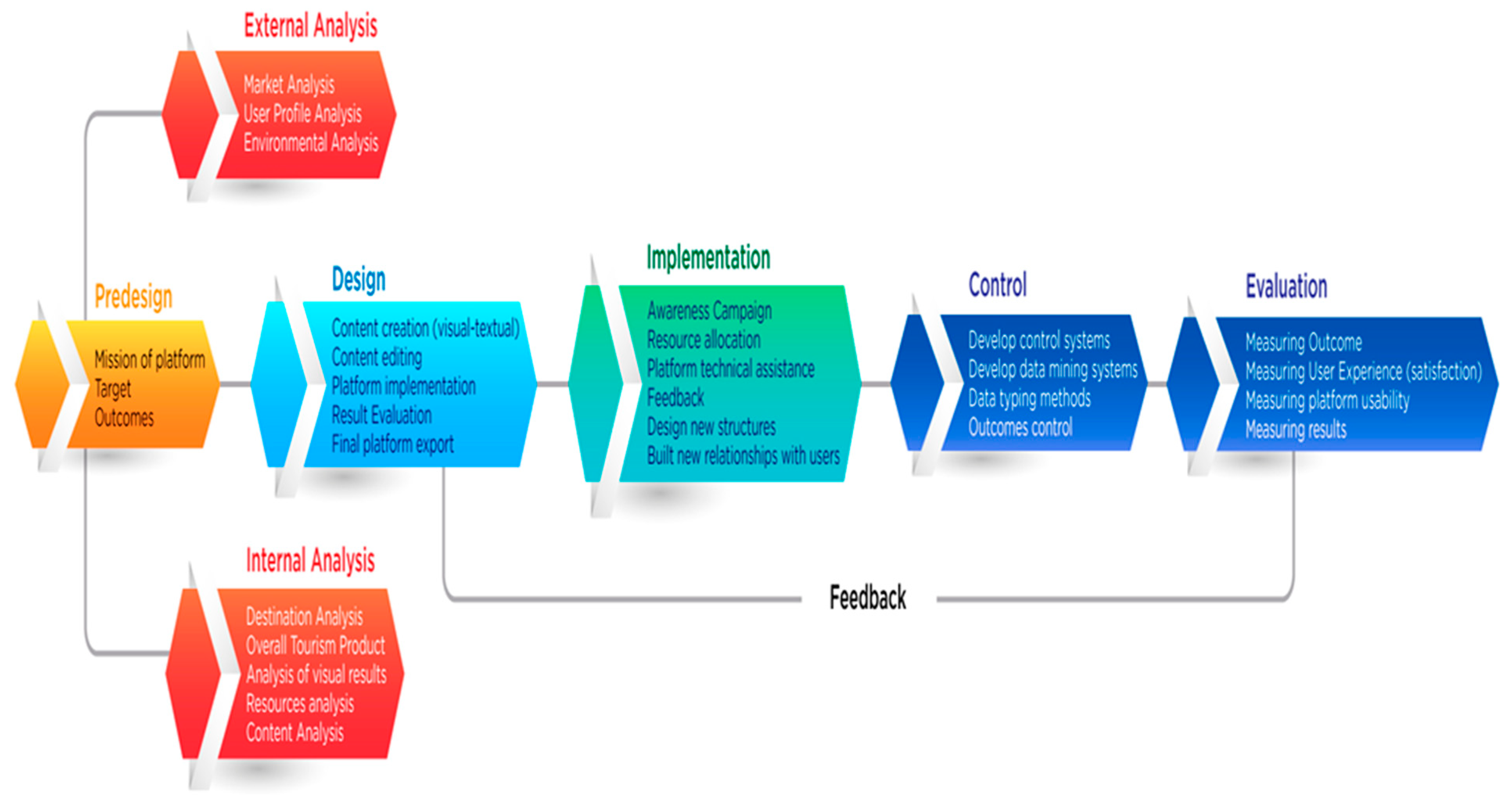
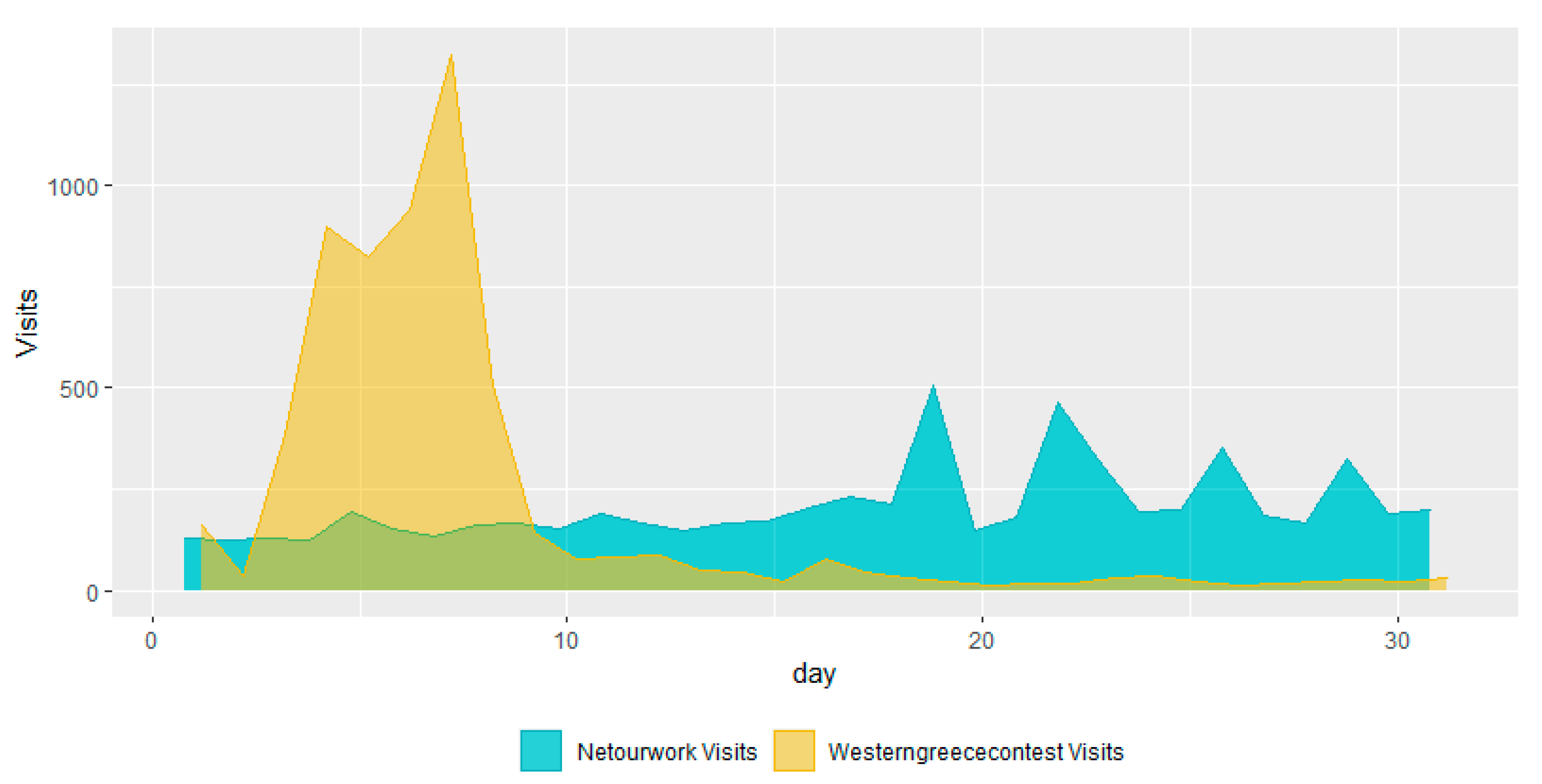
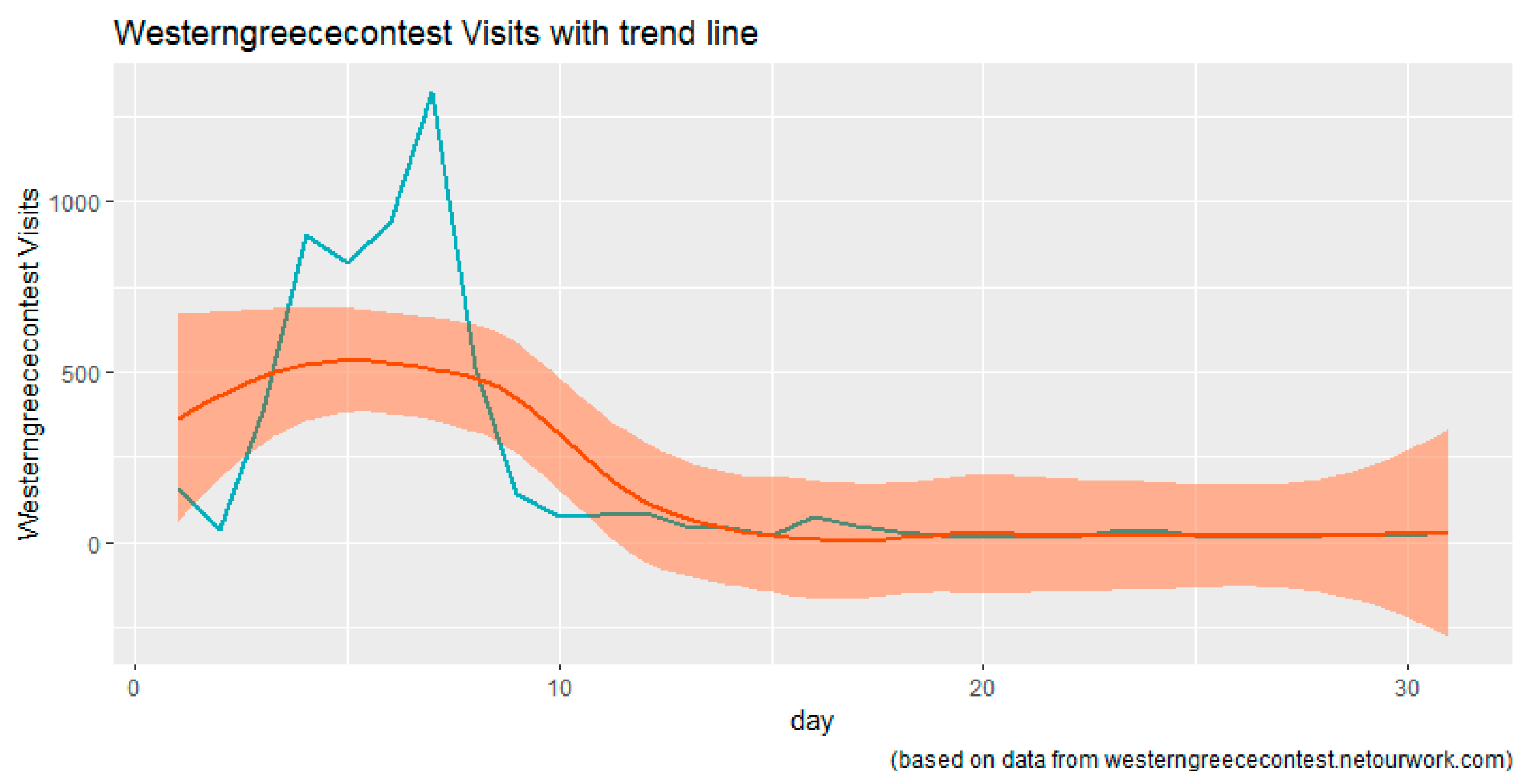
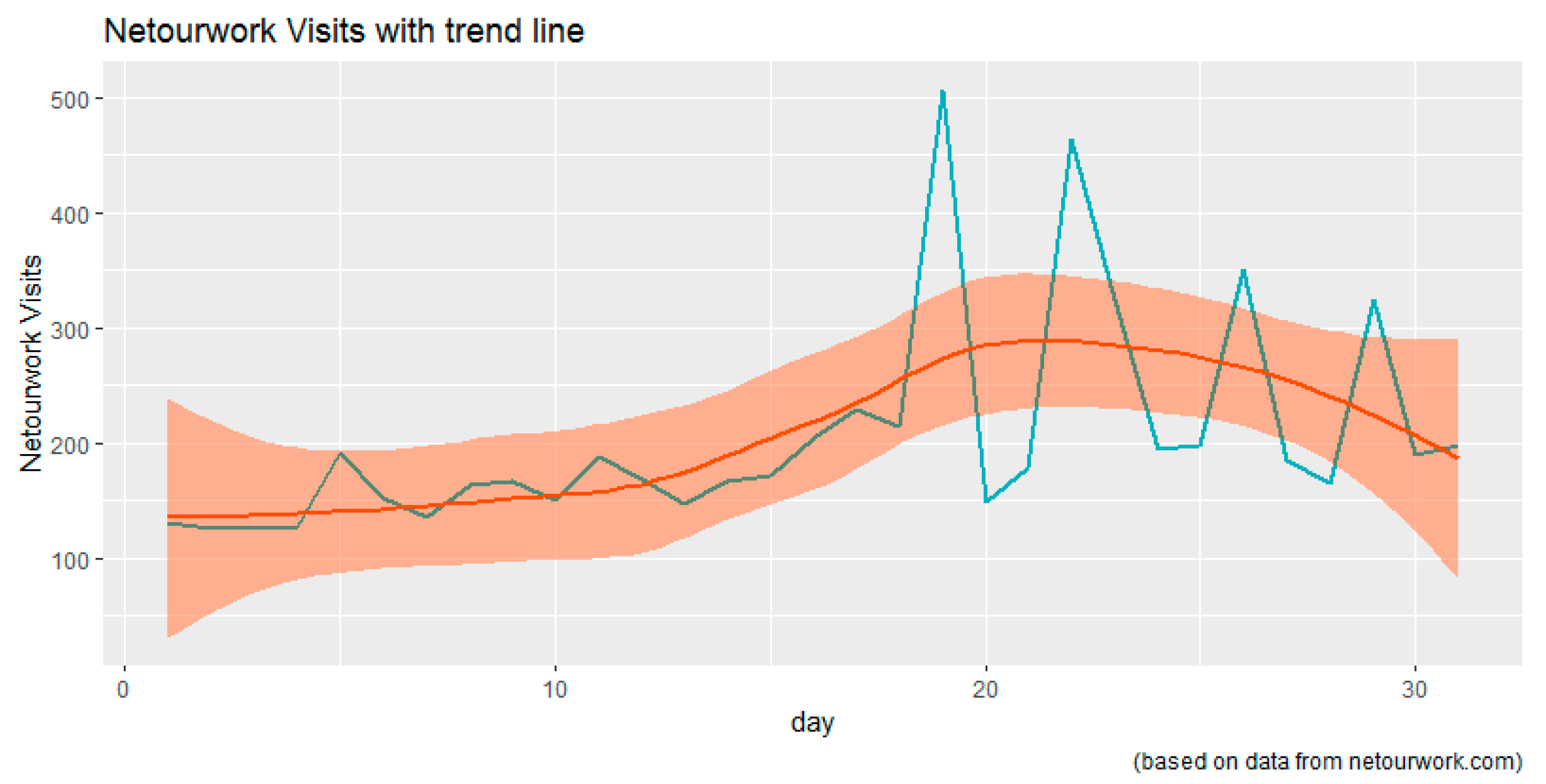

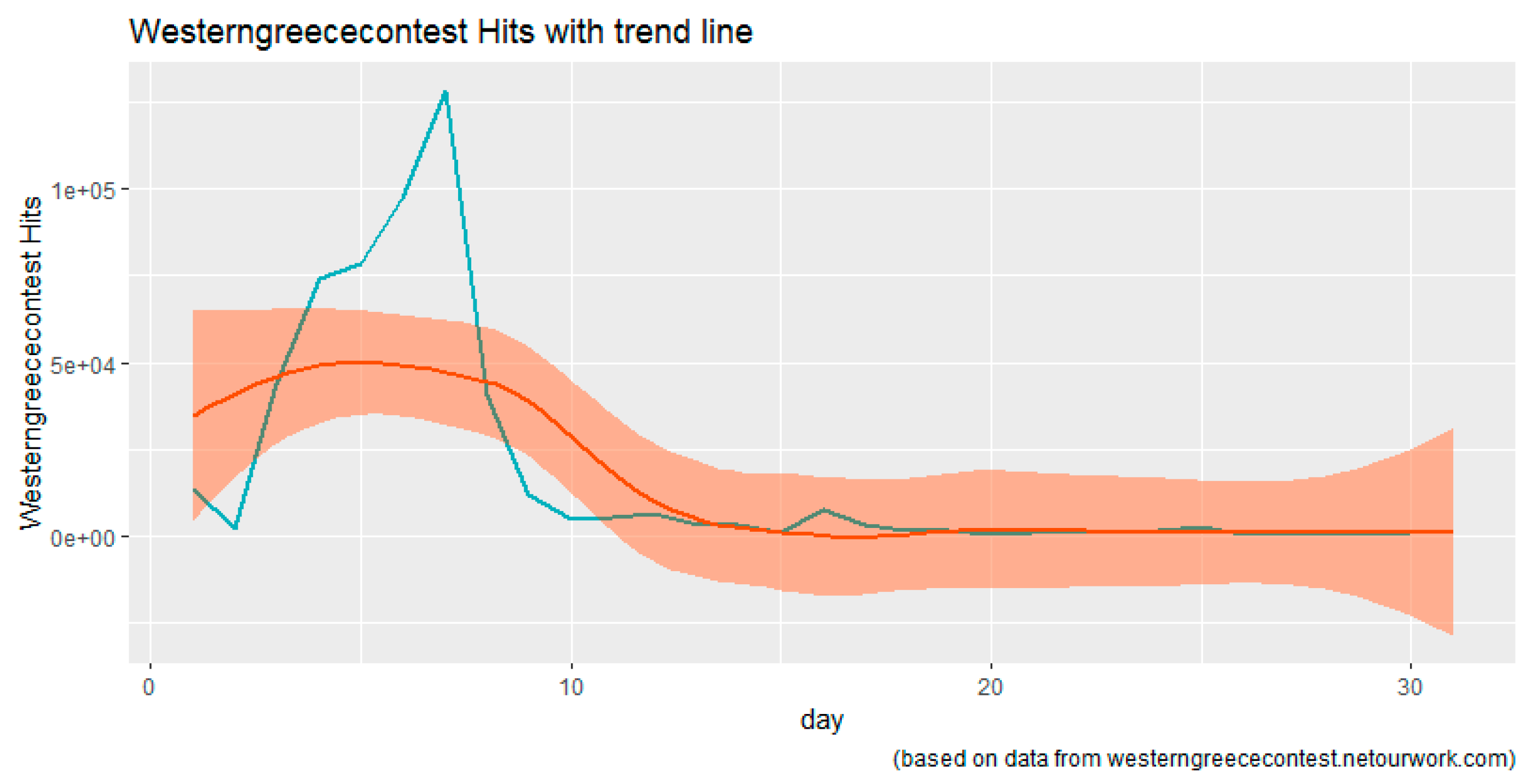

| Westerngreececontest | Netourwork | |
|---|---|---|
| Avg | Avg | |
| Hits per hour | 727 | 171 |
| Hits per day | 17,467 | 4114 |
| Files per day | 17,182 | 3912 |
| Pages per day | 410 | 665 |
| Sites per day | 168 | 115 |
| Visits per day | 194 | 205 |
| KBytes per day | 2,248,839 | 197,277 |
| Number of Time Lags | DF | F-Statistic | p-Value | |
|---|---|---|---|---|
| Test A | 2 | 24, 26 | 4.0903 | 0.0296 * |
| Test B | 2 | 24, 26 | 0.7241 | 0.4951 |
| Test C | 2 | 24, 26 | 2.2636 | 0.0305 * |
| Test D | 2 | 24, 26 | 0.4993 | 0.6131 |
Publisher’s Note: MDPI stays neutral with regard to jurisdictional claims in published maps and institutional affiliations. |
© 2022 by the author. Licensee MDPI, Basel, Switzerland. This article is an open access article distributed under the terms and conditions of the Creative Commons Attribution (CC BY) license (https://creativecommons.org/licenses/by/4.0/).
Share and Cite
Varelas, S. Virtual Immersive Platforms as a Strategic Innovative Destination Marketing Tool in the COVID-19 Era. Sustainability 2022, 14, 12867. https://doi.org/10.3390/su141912867
Varelas S. Virtual Immersive Platforms as a Strategic Innovative Destination Marketing Tool in the COVID-19 Era. Sustainability. 2022; 14(19):12867. https://doi.org/10.3390/su141912867
Chicago/Turabian StyleVarelas, Sotirios. 2022. "Virtual Immersive Platforms as a Strategic Innovative Destination Marketing Tool in the COVID-19 Era" Sustainability 14, no. 19: 12867. https://doi.org/10.3390/su141912867
APA StyleVarelas, S. (2022). Virtual Immersive Platforms as a Strategic Innovative Destination Marketing Tool in the COVID-19 Era. Sustainability, 14(19), 12867. https://doi.org/10.3390/su141912867






